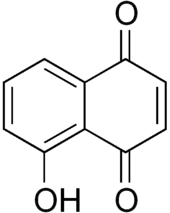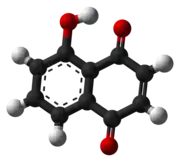Juglone
Juglone, also called 5-hydroxy-1,4-naphthalenedione (IUPAC) is an organic compound with the molecular formula C10H6O3. In the food industry, juglone is also known as C.I. Natural Brown 7 and C.I. 75500. It is insoluble in benzene but soluble in dioxane, from which it crystallizes as yellow needles. It is an isomer of lawsone, which is the active dye compound in the henna leaf.
 | |
 | |
| Names | |
|---|---|
| Preferred IUPAC name
5-Hydroxynaphthalene-1,4-dione | |
Other names
| |
| Identifiers | |
3D model (JSmol) |
|
| 1909764 | |
| ChEBI | |
| ChEMBL | |
| ChemSpider | |
| ECHA InfoCard | 100.006.880 |
| EC Number |
|
PubChem CID |
|
| RTECS number |
|
| UNII | |
CompTox Dashboard (EPA) |
|
| |
| |
| Properties | |
| C10H6O3 | |
| Molar mass | 174.155 g·mol−1 |
| Appearance | Yellow solid |
| Melting point | 162 to 163 °C (324 to 325 °F; 435 to 436 K) |
| Slightly sol. | |
| Related compounds | |
Related compounds |
quinone |
Except where otherwise noted, data are given for materials in their standard state (at 25 °C [77 °F], 100 kPa).
Infobox references | |
Juglone occurs naturally in the leaves, roots, husks, fruit (the epicarp), and bark of plants in the Juglandaceae family, particularly the black walnut (Juglans nigra), and is toxic or growth-stunting to many types of plants.[1] It is sometimes used as an herbicide, as a dye for cloth and inks, and as a coloring agent for foods and cosmetics.
History
The allelopathic effects of walnut trees on other plants were observed as far back as the 1st century CE.[2] Juglone itself was first isolated from black walnut in 1856, and was identified as the compound responsible for its allelopathic effects in 1881.[2]
In 1921, a study observed that tomato plants near black walnut trees exhibited wilted leaves, suggesting an adverse interaction.[3] In 1926, instances of apple tree damage caused by both Juglans nigra and Juglans cinerea (butternut) trees were reported in northern Virginia.[4] Certain apple tree varieties displayed varying levels of resistance to walnut toxicity.
In 1926, it was observed that walnut trees in alfalfa fields resulted in crop death, while grass remained unaffected.[5] Subsequent experiments indicated that the toxic compound within walnut trees exhibited limited solubility in water, implying that the compound underwent chemical changes upon leaving the tree. It was only in 1928 that the phytotoxic nature of the compound was identified for other plant species.[6]
The scientific community faced controversy when the harmful effects of walnut trees on certain crops and trees were initially reported, following claims that the trees damaging apple trees in northern Virginia were not walnut trees at all.[7]
In 1942 it was demonstrated that tomato and alfalfa germination and seedling growth were inhibited by contact with pieces of walnut roots, providing additional scientific evidence of juglone's phytotoxicity.[8]
Juglone was used medicinally in America during the early 1900s, prescribed for the treatment of various skin diseases.[9]
Chemistry
Synthesis
Juglone is derived by oxidation of hydrojuglone, 1,5-dihydroxynaphthalene, after enzymatic hydrolysis.[10] It can also be obtained by oxidations of 5,8-dihydroxy-1-tetralone with silver oxide (Ag2O), manganese dioxide (MnO2), or 2,3-dichloro-5,6-dicyano-1,4-benzoquinone (DDQ).[11]
Extraction
Juglone has been extracted from the husk of walnut fruit of which it contains 2-4% by fresh weight.[12][13]
Degradation
Before oxidization, juglone exists in plants such as walnuts in the form of colorless hydroxyjuglone, with both O groups replaced with OH groups. This is rapidly oxidized to juglone once exposed to air. The evidence that hydroxyjuglone is readily degraded is most apparent in the color change of walnut hulls from yellow to black after being freshly cut.[14]
Indigenous bacteria found in the soil of black walnut roots, most notably Pseudomonas putida J1, are able to metabolize juglone and use it as their primary source of energy and carbon.[15] Because of this, juglone is not so active as a cytotoxin in well-aerated soils.[16]
Spectral data
The spectral data for juglone are consistent with the structure. The IR spectrum for juglone shows peaks at 3400, 1662, and 1641 cm−1 which are characteristic respectively of the hydroxyl and two carbonyl groups.[17] The 13C NMR spectrum shows 10 peaks, including signals at 160.6, 183.2, and 189.3 ppm for the hydroxyl and two carbonyl carbons.[17][11]
Biological effects
Juglone is an allelopathic compound, a substance produced by a plant to stunt the growth of another plant. Juglone affects germination of plants less than it affects growth of the root and stem systems. In below average concentrations, it has increased the rate of germination in some coniferous seeds.[18]
Juglone exerts its effect by inhibiting certain enzymes needed for metabolic function. This in turn inhibits the effects of respiration of mitochondria and inhibits photosynthesis found in common crops such as maize and soy at juglone concentrations that are at or below those common in nature.[19][20] In addition to these inhibitions, juglone has been shown to alter the relationship between plants and water because of its effect on stomatal functioning.[21]
The rise in popularity of alley cropping with black walnut trees and maize in the American Midwest, due to the high value of black walnut trees, has led to certain studies being conducted about the particular relationship between the two species. Research has shown that juglone affects the yield of maize crops; however, the practice of pruning and usage of root barriers greatly reduce these effects.[22]
Some plants and trees are resistant to juglone including some species of maple (Acer), birch (Betula), and beech (Fagus).
It is highly toxic to many insect herbivores. However, some of them, example Actias luna (Luna moth), can detoxify juglone (and related naphthoquinones) to non-toxic 1,4,5-trihydroxynaphthalene. It has also shown anthelmintic (expelling parasitic worms) activity on mature and immature Hymenolepis nana in mice.[23] Naphthoquinonic compounds also exhibit antimicrobial activity.[24][25][26]
Uses
Juglone is occasionally used as a herbicide. Traditionally, juglone has been used as a natural dye for clothing and fabrics, particularly wool, and as ink. Because of its tendency to create dark orange-brown stains, juglone has also found use as a coloring agent for foods and cosmetics, such as hair dyes.
See also
References
- Juglone toxicity Archived 2015-02-12 at the Wayback Machine
- Soderquist, Charles J. (1973). "Juglone and allelopathy". Journal of Chemical Education. 50 (11): 782–3. Bibcode:1973JChEd..50..782S. doi:10.1021/ed050p782. PMID 4747927.
- Cook, M.T. (1921). "Wilting caused by walnut trees". Phytopathology. 11: 346.
- Schneiderhan, F.J. (1926). "Apple disease studies in northern Virginia". Virginia Agricultural Experiment Station Bulletin. 245: 1–35.
- Massey, A.B. (1928). "Are nut trees poisonous to other trees and plants?". Flower Grower. 15: 4.
- Willis, Rick J. (2007-10-12). The History of Allelopathy. Springer Science & Business Media. ISBN 9781402040931.
- Miller, A.G. (1926). "Walnuts and apples". Farm Journal. 1926 (July): 17.
- Brown, B.I. (1942). "Injurious influence of bark of black walnut on seedlings of tomato and alfalfa". North Nut Growers Association Annual Report. 33: 97–102.
- M. Strugstad (2012). "A Summary of Extraction, Synthesis, Properties, and Potential Uses of Juglone: A Literature Review". Journal of Ecosystems and Management. 13 (3): 72–82.
- Gerald Booth "Naphthalene Derivatives" in Ullmann's Encyclopedia of Industrial Chemistry, 2005, Wiley-VCH, Weinheim. doi:10.1002/14356007.a17_009.
- J. Khalafy; J.M. Bruce (2002). "Oxidative dehydrogenation of 1-tetralones: Synthesis of juglone, naphthazarin, and α-hydroxyanthraquinones". Journal of Sciences, Islamic Republic of Iran. 13 (2): 131–139.
- Combes, M. R. (1907). "Bulletin de la Société chimique de France". Combes, Bull. Soc. Chim. (in French). 1 (4): 800–816. Retrieved 14 October 2016.
- Cosmulescu, Sina Niculina; Trandafir, Ion; Achim, Gheorghe; Botu, Mihai; Baciu, Adrian; Gruia, Marius (15 June 2010). "Phenolics of Green Husk in Mature Walnut Fruits". Notulae Botanicae Horti Agrobotanici Cluj-Napoca. 38 (1): 53–56. doi:10.15835/nbha3814624 (inactive 1 August 2023). ISSN 1842-4309. Retrieved 11 October 2016.
{{cite journal}}: CS1 maint: DOI inactive as of August 2023 (link) - Gries, G.A. (1943). "Juglone - the active agent in walnut toxicity". Northern Nut Growers Association Annual Report. 34: 52–55.
- Schmidt, S.K. (1988). "Degradation of juglone by soil bacteria". Journal of Chemical Ecology. 14 (7): 1561–1571. doi:10.1007/bf01012522. PMID 24276429. S2CID 527864.
- Fisher, R.F. (1987). "Juglone inhibits pine growth under certain moisture regimes". Soil Sci. Soc. Am. J. 42 (5): 801–803. doi:10.2136/sssaj1978.03615995004200050030x.
- Suchard, Oliver; Kane, Ronan; Roe, Bernard J.; Zimmermann, Elmar; Jung, Christian; Waske, Prashant A.; Mattay, Jochen; Oelgemöller, Michael (2006). "Photooxygenations of 1-naphthols: An environmentally friendly access to 1,4-naphthoquinones". Tetrahedron. 62 (7): 1467. doi:10.1016/j.tet.2005.11.021.
- Rietveld, W J (1983). "Allelopathic effects of juglone on germination and growth of several herbaceous and woody species". J. Chem. Ecol. 9 (2): 295–308. CiteSeerX 10.1.1.550.5739. doi:10.1007/bf00988047. PMID 24407348. S2CID 23491349.
- Koeppe, D.E. (1972). "Some reactions of isolated corn mitochondria influenced by juglone". Physiol. Plant. 27: 89–94. doi:10.1111/j.1399-3054.1972.tb01142.x.
- Hejl, A.M.; Einhellig, F.A.; Rasmussen, J.A. (1993). "Effects of juglone on growth, photosynthesis, and respiration". J. Chem. Ecol. 19 (3): 559–568. doi:10.1007/bf00994325. PMID 24248956. S2CID 22740992.
- Einhelling F.A. 1986 Mechanisms and modes of action of allelochemicals. In The Science of Allelopathy. Eds. A R Putnam and C S Tang. pp 171–188. John Wiley & Sons, New York
- Jose, Shibu; Gillespie, Andrew R. (1998). "Allelopathy in black walnut (Juglans nigra L.) alley cropping. I. Spatio-temporal variation in soil juglone in a black walnut–corn (Zea mays L.) alley cropping system in the midwestern USA". Plant and Soil. 203 (2): 191–197. doi:10.1023/A:1004301309997. S2CID 41384254.
- Dama L.B.; Jadhav B.V. (1997). "Anthelmintic effect of Juglone on mature and Immature Hymenolepis nana in mice". Riv. Di Parassitol. 2: 301–302.
- Dama L.B.; Poul B.N.; Jadhav B.V. (1998). "Antimicrobial activity of Napthoquinonic compounds". J. Ecotoxicol.Environ. Monit. 8: 213–215.
- Dama L.B.; Poul B.N.; Jadhav B.V; Hafeez MD. (1999). "Effect of "Juglone" on Development of the plant parasitic nematode (Meloidogyne Spp.) on Arachis hypogaea L". J. Ecotoxicol. Environ. Monit. 9: 73–75.
- Dama L.B. (2002). "Effect of naturally occurring napthoquinones [sic] on root- knot nematode Meloidogyne spp". Indian Phytopathology. 55 (1): 67–69.